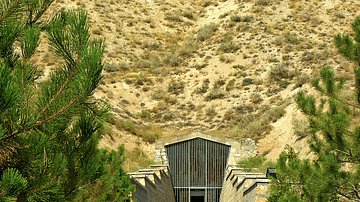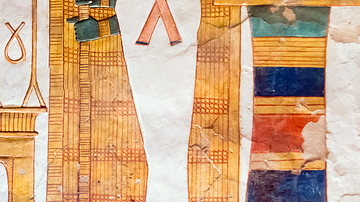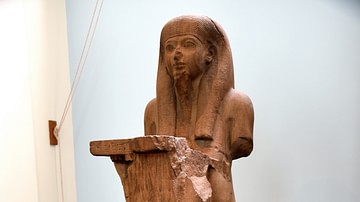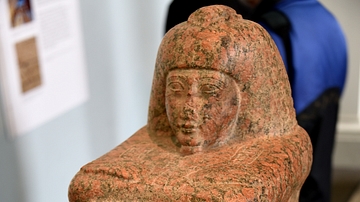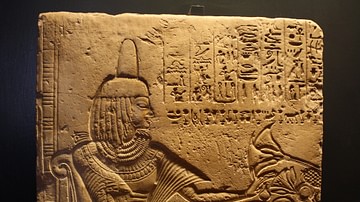Illustration
When complete, this scene showed Osorkon offering a clepsydra (water clock) to the snake goddess Wadjyt. The King wears the double crown of Upper and Lower Egypt. Osorkon's wife, queen Karoma, stands by his side. She wears a plumed crown with sun-disc and holds a fly-whisk and an ankh, the hieroglyphic symbol of life. Her portly figure reflects the female ideal of the time. The block comes from a monumental gateway in Bubastis. Its relief depicts Osorkon's sed jubilee, at which a king's god-given powers were ritually renewed. The arrangement of the scenes mirrored Egypt's dual territory, which was formally reclaimed by the rejuvenated ruler. The scenes on the gate's north and south halves showed Osorkon, respectively, as a king of Lower and Upper Egypt (Nile Delta and Valley). Here, he wears the crowns of both regions combined, but as this block comes from the northern half, it showed him worshipping Wadjyt, patron goddess of dominion over Lower Egypt. A matching scene on the South half featured the vulture goddess Nekhbet, who represented dominion over Upper Egypt. 22nd Dynasty, reign of Osorkon II, circa 874-850 BCE. From Bubastis (Tell Basta), temple of Baset, Egypt. (The British Museum, London).
About the Author
Cite This Work
APA Style
Amin, O. S. M. (2016, July 18). Tomb Relief of King Osorkon II. World History Encyclopedia. Retrieved from https://www.worldhistory.org/image/5350/tomb-relief-of-king-osorkon-ii/
Chicago Style
Amin, Osama Shukir Muhammed. "Tomb Relief of King Osorkon II." World History Encyclopedia. Last modified July 18, 2016. https://www.worldhistory.org/image/5350/tomb-relief-of-king-osorkon-ii/.
MLA Style
Amin, Osama Shukir Muhammed. "Tomb Relief of King Osorkon II." World History Encyclopedia. World History Encyclopedia, 18 Jul 2016. Web. 15 Apr 2025.



